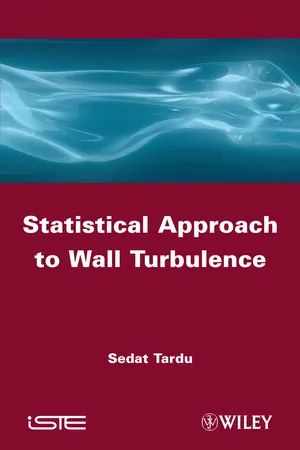
- English
- ePUB (mobile friendly)
- Available on iOS & Android
Statistical Approach to Wall Turbulence
About this book
Wall turbulence is encountered in many technological applications as well as in the atmosphere, and a detailed understanding leading to its management would have considerable beneficial consequences in many areas. A lot of inspired work by experimenters, theoreticians, engineers and mathematicians has been accomplished over recent decades on this important topic and Statistical Approach to Wall Turbulence provides an updated and integrated view on the progress made in this area.
Wall turbulence is a complex phenomenon that has several industrial applications, such as in aerodynamics, turbomachinery, geophysical flows, internal engines, etc. Several books exist on fluid turbulence, but Statistical Approach to Wall Turbulence is original in the sense that it focuses solely on the turbulent flows bounded by solid boundaries. The book covers the different physical aspects of wall turbulence, beginning with classical phenomenological aspects before advancing to recent research in the effects of the Reynolds numbers, near wall coherent structures, and wall turbulent transport process.
This book would be of interest to postgraduate and undergraduate students in mechanical, chemical, and aerospace engineering, as well as researchers in aerodynamics, combustion, and all applications of wall turbulence.
Frequently asked questions
- Essential is ideal for learners and professionals who enjoy exploring a wide range of subjects. Access the Essential Library with 800,000+ trusted titles and best-sellers across business, personal growth, and the humanities. Includes unlimited reading time and Standard Read Aloud voice.
- Complete: Perfect for advanced learners and researchers needing full, unrestricted access. Unlock 1.4M+ books across hundreds of subjects, including academic and specialized titles. The Complete Plan also includes advanced features like Premium Read Aloud and Research Assistant.
Please note we cannot support devices running on iOS 13 and Android 7 or earlier. Learn more about using the app.
Information
Chapter 1
Basic Concepts
1.1. Introduction
1.2. Fundamental equations
1.2.1. Euler equations



1.2.1.1. Continuity equation




Table of contents
- Cover
- Title Page
- Copyright
- Foreword
- Introduction
- Chapter 1: Basic Concepts
- Chapter 2: Preliminary Concepts: Phenomenology, Closures and Fine Structure
- Chapter 3: Inner and Outer Scales: Spectral Behavior
- Chapter 4: Reynolds Number-Based Effects
- Chapter 5: Vorticity
- Notations Used
- Bibliography
- Index